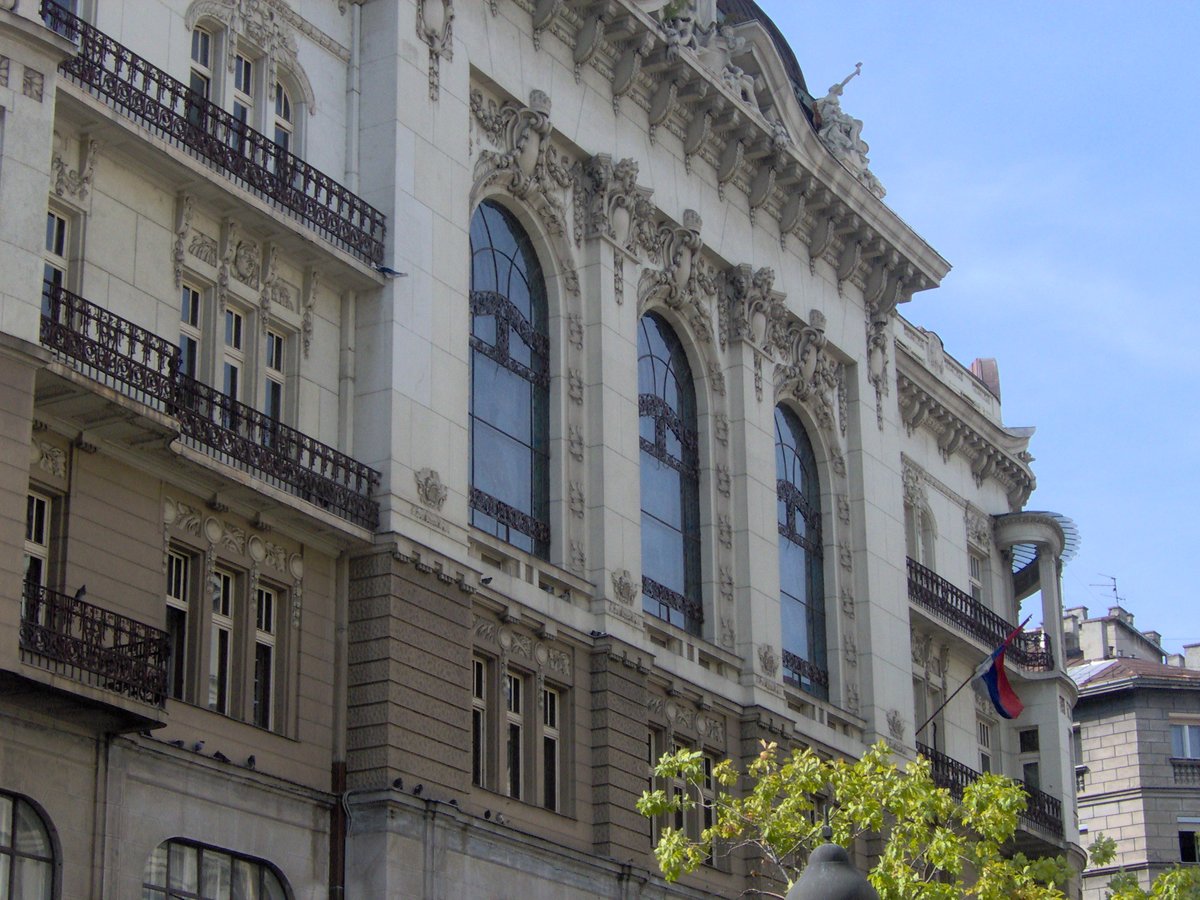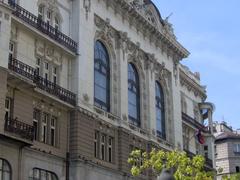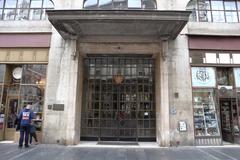
Serbian Academy of Sciences and Arts Building: Visiting Hours, Tickets, and Complete Guide to a Belgrade Historic Landmark
Date: 15/06/2025
Introduction
Situated prominently at 35 Knez Mihailova Street, the Serbian Academy of Sciences and Arts (SANU) Building stands as a cornerstone of Belgrade’s intellectual and cultural landscape. Since its completion in 1924, this architectural masterpiece has embodied the nation’s commitment to science, the arts, and the preservation of Serbian heritage. SANU’s roots stretch back to the Society of Serbian Letters in 1841, evolving over nearly two centuries into Serbia’s leading scholarly institution. Today, the building is not only a monument to academic achievement and architectural grandeur but also a vibrant cultural hub, welcoming visitors from around the world to experience exhibitions, guided tours, and public events (SASA Official; InterAcademies).
Table of Contents
- Historical Origins and Institutional Evolution
- Architectural Significance and Building Features
- Cultural Role and Notable Events
- Visitor Information: Hours, Tickets, and Tours
- Accessibility and Visitor Facilities
- Getting There and Nearby Attractions
- Tips for a Memorable Visit
- Frequently Asked Questions (FAQ)
- Visuals and Media
- Conclusion and Call to Action
- References
Historical Origins and Institutional Evolution
Founded as the Society of Serbian Letters in 1841 and formalized as the Serbian Royal Academy in 1886, SANU has played a pivotal role in Serbia’s intellectual development (InterAcademies). The Academy absorbed the Serbian Learned Society in 1892, consolidating its position as the nation’s foremost institution for science and the arts (Council Science). SANU’s membership has included Nobel laureates and renowned intellectuals, and its influence extends through educational reforms, scientific policy, and cultural preservation.
Architectural Significance and Building Features
Exterior and Façade
The SANU Building, designed by Dragutin Đorđević and Andra Stevanović, is a landmark of early 20th-century academic classicism with Art Nouveau influences. Its symmetrical façade, complete with ornate stonework, pilasters, and sculptural decorations—including six children’s figures in the attic—presents a palatial presence on Knez Mihailova Street. The building occupies an entire city block and is widely regarded as one of Belgrade’s most visually striking architectural achievements (SASA Official).
Interior Spaces
Inside, the building features spacious marble halls, high ceilings, and elegant staircases. The arrangement includes a basement, ground floor, mezzanine, and two upper floors. The ground floor houses the SANU Gallery, a bookstore, and an antique shop, inviting public engagement. The upper floors are dedicated to the Academy’s library, archives, and scholarly work, with the Congress Hall serving as a venue for lectures and concerts.
Artistic Highlights
A defining feature of the building is its stained glass, particularly the windows in the entrance hall and Congress Hall. These colorful installations—updated in 2000 and 2005 based on designs by Branko Miljuš and Mladen Srbinović—reflect the Academy’s dedication to the arts and contribute to the building’s luminous, contemplative atmosphere.
Technological and Structural Innovations
At the time of its construction, the SANU Building was a pioneer in public health infrastructure, being the first in Belgrade equipped with dust extraction technology. Periodic renovations, such as the 1967 gallery redesign by architect Samojlov, have ensured the building remains functional and welcoming while preserving its historic character.
Cultural Role and Notable Events
The SANU Building is much more than an architectural treasure—it is a living cultural center. It regularly hosts scientific congresses, international symposiums, art exhibitions, concerts, and book launches, drawing thousands of visitors annually. The Academy’s establishment of the Audiovisual Archive and Center for Digitization (AVA SASA) in 2017 demonstrates its commitment to preserving Serbia’s cultural heritage in the digital age (Phase One Project). Prestigious events like the STRAND OA2025 Conference and the MicroMacro Awards place SANU at the heart of ongoing scholarly and artistic dialogue (STRAND Conference).
Visitor Information: Hours, Tickets, and Tours
Opening Hours
- Tuesday to Saturday: 10:00 AM – 6:00 PM
- Closed: Sundays, Mondays, and national holidays
Tickets
- General Admission: Most exhibitions are free of charge. Special exhibitions or guided tours may require tickets (typically 200–500 RSD, or 2–5 EUR).
- Discounts: Free entry for students, seniors, and children under 12. Check the official website for the latest details.
Guided Tours
- Languages: Serbian and English
- Duration: Approximately 60 minutes
- Booking: Tours must be arranged in advance via the SANU website or at the reception desk.
Photography
- Policy: Non-flash photography is generally allowed in public areas. Always check for restrictions during special exhibitions.
Accessibility and Visitor Facilities
- Wheelchair Access: The building is fully accessible, with ramps and elevators connecting all public spaces.
- Facilities: Clean restrooms (including facilities for people with disabilities), air conditioning, and free Wi-Fi in the main lobby.
- Shops: Bookstore and antique shop on the ground floor. Souvenirs and SANU-related materials available.
- Café: No on-site café, but numerous dining options are available nearby.
Getting There and Nearby Attractions
Location
- Address: 35 Knez Mihailova Street, Belgrade
- Public Transport: Multiple bus and tram lines stop at Republic Square, a short walk from SANU.
- Parking: Limited in the city center; public transport or walking is recommended.
Nearby Attractions
- National Museum of Serbia
- Kalemegdan Fortress and Park
- Belgrade City Library
- Republic Square
- Skadarlija Bohemian Quarter
Combine your visit to SANU with a walking tour of Belgrade’s vibrant historic core for a full day of cultural exploration (Belgrade Tourism; Where Goes Rose).
Tips for a Memorable Visit
- Visit in the Afternoon: Enjoy the play of sunlight through the stained glass windows.
- Check the Event Calendar: The Academy’s program is updated frequently; consult the events calendar for lectures, concerts, and special exhibitions.
- Language: Most exhibition materials are bilingual (Serbian and English). Staff are generally helpful and speak English.
- Combine Attractions: Include SANU in your itinerary alongside nearby museums and parks.
- Accessibility Needs: Contact SANU in advance if you have specific accessibility requirements.
Frequently Asked Questions (FAQ)
What are the SANU visiting hours?
Tuesday to Saturday, 10:00 AM – 6:00 PM; closed Sundays, Mondays, and public holidays.
Is there an admission fee?
Most exhibitions are free. Special exhibitions or tours may require a ticket (200–500 RSD).
Are guided tours available?
Yes, in Serbian and English by prior arrangement.
Is the building wheelchair accessible?
Yes, with ramps and elevators.
Can I take photographs inside?
Non-flash photography is permitted in most public areas; check for restrictions during certain exhibitions.
Visuals and Media
- Image suggestion: Exterior view of the SANU building’s Art Nouveau façade (Alt: Serbian Academy of Sciences and Arts building exterior in Belgrade)
- Image suggestion: Stained glass windows in the entrance hall (Alt: Stained glass SANU building Belgrade)
- Image suggestion: Congress Hall interior with elegant staircases (Alt: SANU building Congress Hall interior)
- Map suggestion: Interactive map of Knez Mihailova Street with SANU’s location marked
- Virtual tour: Link from the official website if available
Conclusion and Call to Action
The Serbian Academy of Sciences and Arts Building is more than a historical monument—it is a living institution at the heart of Serbia’s scientific, artistic, and cultural life. Its architectural beauty, central location, and rich program of exhibitions and events make it an essential destination for both residents and tourists. Whether you are passionate about history, architecture, or the arts, a visit to SANU offers a profound connection to Serbia’s national heritage and intellectual legacy.
Plan your visit by checking the latest hours and ticket information on the official SANU website. For a richer experience, download the Audiala app for curated tours, event updates, and insider tips on Belgrade’s cultural landmarks. Stay connected by following SANU and Audiala on social media.
References
- Serbian Academy of Sciences and Arts Official Website
- Visiting the Serbian Academy of Sciences and Arts Building: Hours, Tickets, and Historical Highlights in Belgrade, 2025, InterAcademies
- Phase One Project on Serbian Cultural Heritage Digitization, 2025
- Serbian Academy of Sciences and Arts (SANU) Building: Visiting Hours, Tickets, and Historical Significance in Belgrade, 2025, Belgrade Tourism
- Where Goes Rose: Is Belgrade Worth Visiting?
- TripAdvisor Reviews
For further reading or to plan your visit, consult the above sources and the SANU official website.









































































